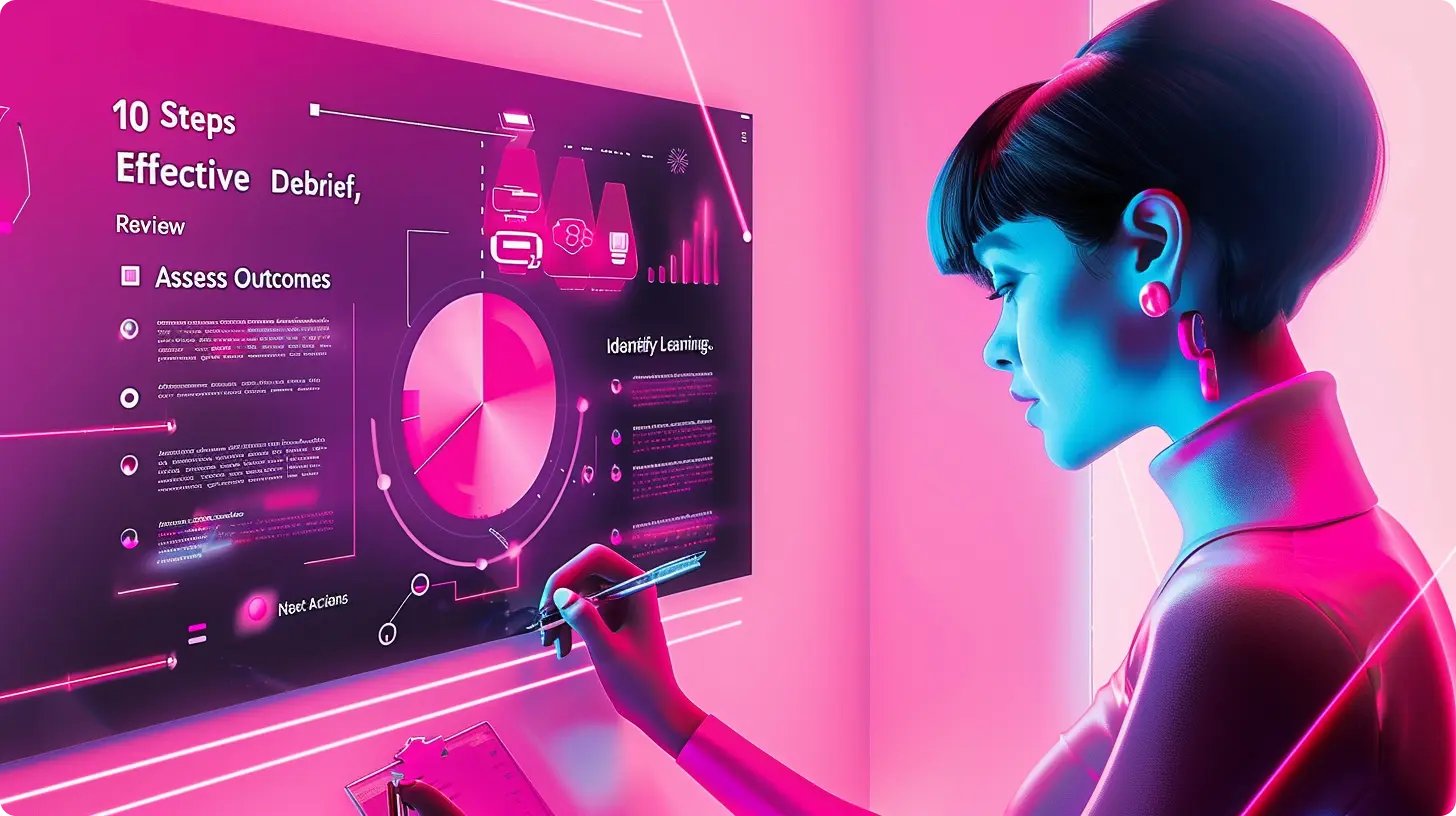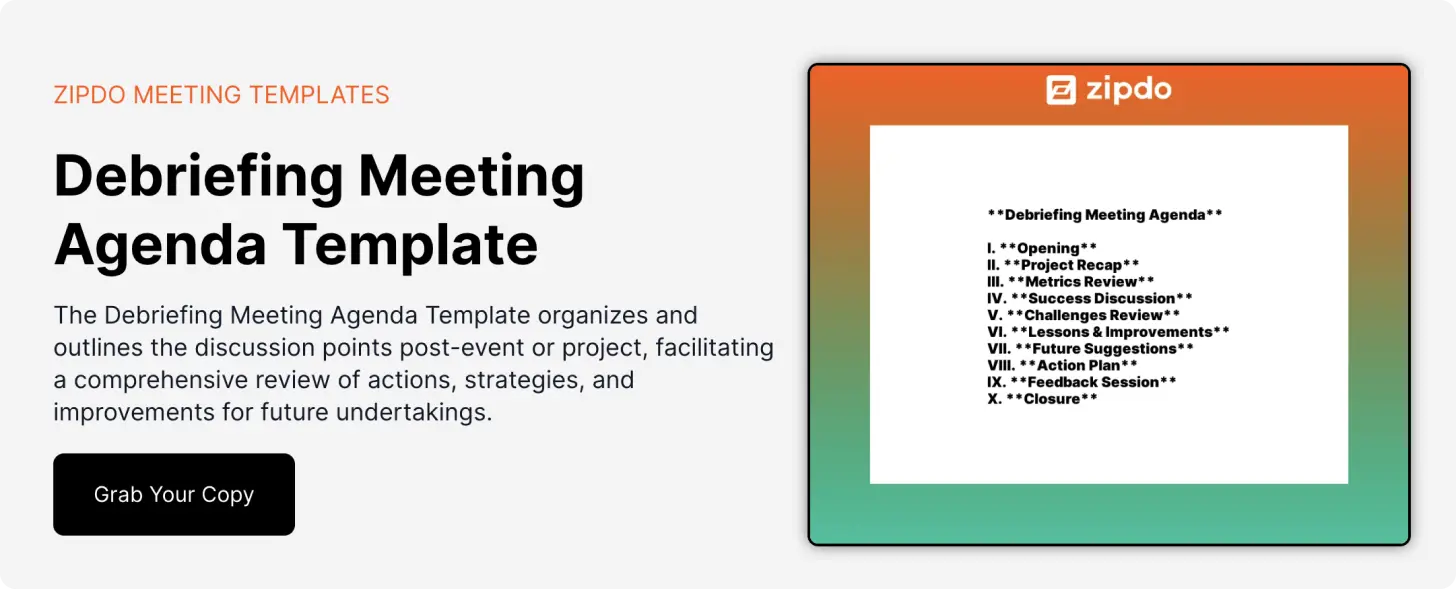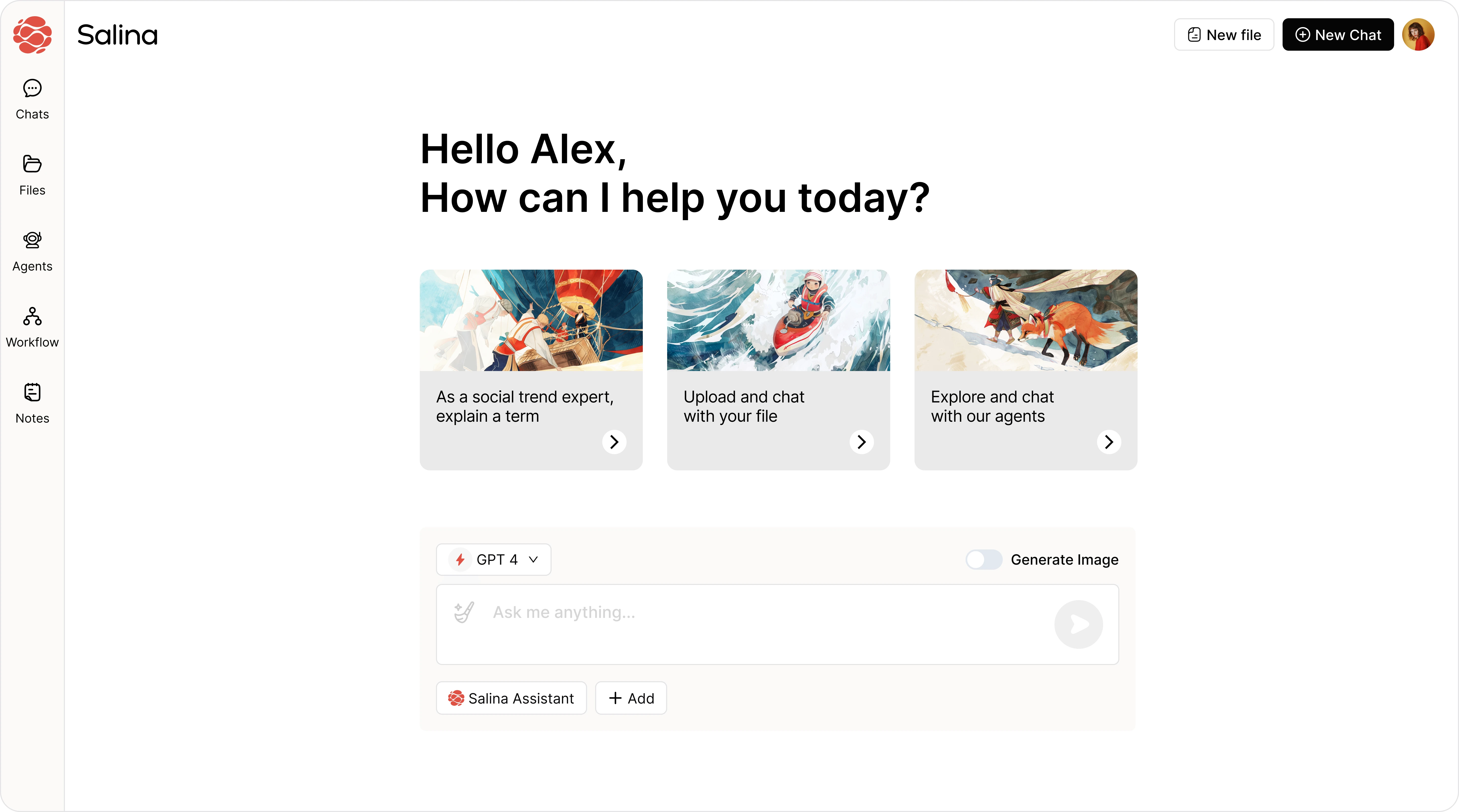
Struggling to turn meeting ideas into action? Conduct an effective meeting debrief to ensure progress and tangible results for your business.
Meetings are often the incubators for important decisions and innovative ideas. Yet, all too often, critical debriefing sessions are neglected, robbing teams of the invaluable opportunity to learn, grow, and recalibrate their strategies.
I can personally attest to this. Just last month, I was tasked to lead a brainstorming session for a new marketing campaign. We left the room feeling inspired, bursting with creative ideas. However, a week later, the energy had dissipated. There was confusion about the next steps, and some great ideas appeared to have disappeared. This situation stemmed from overlooking the debrief.
If you haven’t fully realized the impact of a well-organized meeting debrief yet, it’s time to tap into its potential.
In this detailed guide for business professionals, we’ll go through 10 practical steps to elevate your post-meeting debrief from a routine summary to a source of valuable insights and actions. Mastering this approach, whether you lead a team or play a crucial role in one, can boost communication, support team development, and deliver concrete results for your organization.
Meeting Debriefs: More Than a Formality
The debriefing process often takes a backseat to the excitement and exhaustion that precedes it. The inclination to rush past the debrief is understandable, given the need to “get back to business.” But, as we’ll explore, the meeting debrief represents a rare, concentrated moment that can yield substantial professional dividends.
Debriefs aren’t just about recapping what happened. They allow participants to digest the outcomes, dissect challenges and successes, and crucially, to outline clear and actionable steps for the future. Avoiding this critical step in the meeting lifecycle is to squander the most fertile ground for growth and progress.
This insight is better said by Scott Tannenbaum, President of The Group of Organizational Effectiveness, Inc., a company that offers consulting, research, and tools to over 600 organizations worldwide, with a significant presence in the Fortune 100. He shared this perspective on the No Way Out podcast, hosted by Brian Rivera, the co-creator of The Flow System for design.
The LinkedIn post below offers a concise summary of their key talking points and discussion.
When to Schedule Your Meeting Debrief
Scheduling a debrief is half the battle, but knowing when to bring your team back to the table is the other, equally important half. There is an art to choosing the right moment, and it is less about the time on a clock and more about the milestones in your projects or the gravity of your decisions.
Right After Critical Decisions
Energy and context are effortlessly captured following the immediate aftermath of a decision or action. There’s a rawness and immediacy to these debriefs that can be taken advantage of to inform later, more strategic conversations.
Project Milestones
After a key milestone, a debrief ensures that everyone has a shared understanding of what transpired and why, often leading to more focused and effective planning for the next phase.
After Challenging Situations
Debriefing meets trials head-on, offering participants the space to reflect on what went wrong and why, allowing the team to emerge stronger, more resilient, and wiser.
Step-by-Step Guide to an Effective Meeting Debrief
Now, for the heart of the matter. Conducting an effective debrief requires structure, intent, and a touch of genuine inquiry. Follow these steps to ensure your post-meeting discussions are as fruitful as the meetings themselves.
1. Initiate an “Immediate Reflection Session”
Transform your debrief into a unique “Immediate Reflection Session” that starts right as the meeting wraps up, promoting a culture of instant feedback and action. This innovative approach ensures participants’ insights and emotions are captured while still fresh, making the session a natural, dynamic extension of the meeting.
Boosting spontaneity and quick communication establishes you as a leader in efficient meeting management. Focus on ongoing improvement and gathering proactive feedback in real time.
Post-meeting forgetfulness is a genuine phenomenon experienced by many, as evidenced by this Reddit thread.
With this problem in mind, conducting a prompt reflection session or debriefing meeting could be a valuable solution. Rather than passively attending a meeting, you would be encouraged to provide insights from the discussion that took place, ensuring greater engagement.
2. Create a Focused Agenda
Structure your debrief with a clear, outcome-focused agenda. It’s important to note that your debrief agenda doesn’t have to replicate the meeting agenda exactly. Customize it to align with your debrief’s specific goals, whether they involve strategic alignment, process review, or problem resolution. This tailored approach ensures that your debrief effectively addresses the intended objectives.
3. Choose the Right Venue
Incorporating a debrief session in a setting separate from the main meeting venue can provide a new and insightful outlook.
It’s essential to choose a location that fosters open and honest discussions, such as a physical room with round-table seating for face-to-face interactions or a dedicated virtual platform tailored for seamless collaboration among participants. This deliberate choice of environment can enhance the quality of communication and promote deeper insights and reflections post-meeting.
4. Collaborate on Talking Points
Open the floor for discussion points from all participants before the meeting. This simple yet effective practice allows everyone to share their thoughts, ensuring a diverse range of perspectives are considered. A nominal investment of time in this pre-debrief phase typically leads to richer, more candid conversations during the debrief, fostering deeper insights and collaborative problem-solving.
(Suggest using online collaboration tools to gather discussion points from all participants beforehand)
Tools to the Rescue!
Trello: A visual project management tool, that facilitates seamless team collaboration with boards, lists, and cards to organize tasks and ideas. Its AI-powered feature, “Butler,” smartly integrates with team workflows, automating organizational tasks and enhancing the efficiency of preparing for debriefs.
Slack: While not AI-powered itself, Slack integrates with various AI tools and bots that can facilitate gathering and organizing discussion points. It’s a communication platform that allows for the creation of channels for specific topics, where participants can share ideas and feedback before the meeting.
5. Capture the Conversation
In the traditional approach to debriefs, assigning a team member to capture important insights and decisions was the norm, ensuring that critical information was documented for future reference. This method, while effective, often requires significant effort and could result in missed details or biased interpretations.
The modern approach, however, embraces the advancements in technology, specifically AI, to perform this task with unprecedented efficiency and accuracy. By taking advantage of AI note-taking tools, teams can now automatically transcribe discussions, highlight key insights, and organize information in a manner that is easily accessible and searchable.
The shift not only frees team members to fully engage in the conversation but also guarantees a more comprehensive and objective capture of the debrief’s outcomes, marking a significant evolution in how businesses document and learn from their meetings.
AI Note-Taking Tools to the Rescue!
Otter.ai: Offers real-time transcription services that capture and transcribe conversations, meetings, and presentations, providing searchable, shareable transcripts with highlights and the ability to add comments or notes.
Fireflies.ai: An AI-powered tool that records, transcribes, and searches across your meetings. It integrates with popular video conferencing platforms and offers insights into meetings through automated summaries and action items.
Also Read: How to Efficiently Transcribe Meeting Minutes
6. Ask Open-Ended Questions
Encourage deep reflections by asking open-ended questions that invite thoughtful responses and spark introspection. Instead of just yes or no answers, explore the challenges faced, the surprises encountered, and the opportunities that emerged.
Foster a culture of inquiry, curiosity, and exploration to inspire meaningful discussions and gain valuable insights and perspectives.
Examples of Open-Ended Questions:
- What aspects of the meeting exceeded your expectations, and why?
- Can you describe a challenge you faced during this project and how you addressed it?
- What were some of the most surprising outcomes of our discussions today?
- In what ways can we improve our collaboration for future projects?
- How do you feel the strategies we implemented impacted the meeting’s outcomes?
7. Revisit the Objectives
Does the team collectively agree on the meeting’s objectives, and were those objectives successfully met? This critical evaluation process forms a central pillar of effective debriefing sessions, emphasizing the importance of alignment and consensus-building within the team.
It is common for objectives to undergo transformations or misinterpretations during the course of a project, making the debriefing session vital in realigning all stakeholders and confirming that everyone is working towards the same goals and outcomes.
8. Celebrate Victories, Big and Small
Recognition is a fundamental human need that plays a vital role in our emotional well-being. It is important not only to seek acknowledgment from others but also to appreciate our own accomplishments. Whether these victories are individual triumphs or achievements as part of a team effort, they serve as powerful sources of motivation.
The recognition and celebration of these successes, not only boost our own morale but also inspire others to pursue excellence in their endeavors. This ties in with the importance of recognition and positive feedback during meeting debriefs.
John Spence, a leading business and leadership expert, emphasizes the importance of recognizing employee successes for a positive work environment. Acknowledgment boosts morale, loyalty, and attracts top talent.
This fosters a culture that values recognition and collaboration and creates a motivated workforce. Spence advises on offering authentic, tailored praise and promoting a culture of celebration for all achievements in this LinkedIn post.
9. Identify Roadblocks and Opportunities for Growth
A debrief isn’t solely about looking back; it’s a valuable opportunity to learn from past experiences, enabling the team to pave the way for future success. This process entails reflecting deeply on what worked effectively, and areas that could benefit from enhancements, recognizing obstacles encountered, and strategically devising constructive solutions.
Incorporating feedback, candidly addressing impediments, and maintaining a solution-oriented mindset enable teams to significantly elevate their performance, thereby creating a solid foundation for even greater success in the future.
10. Forge a Path Forward
All the reflection and discussion in a debrief are essential for extracting valuable insights. This process should culminate in a well-defined and actionable path forward. It is important to take the time to thoroughly analyze the outcomes of the debrief, identifying key areas for improvement and growth.
Developing clear and detailed strategies based on the lessons learned during the debrief can allow you to create a roadmap that outlines concrete steps and assigns specific individuals as owners. This level of detail ensures accountability and sets the stage for the successful implementation of the identified improvements.

To start and improve your debriefing meetings with your team, check out this useful template from Zipdo. Take advantage of this resource to organize your sessions well, so you can gather important insights and actions for ongoing success and growth.
Key Takeaways
- Capturing meeting essence enhances learning, team dynamics, and focus on progress.
- Implementing 10 steps elevates debriefs from routine to dynamic, value-driven sessions.
- Effective debriefs offer personalized benefits for teams through strategic practices.
- Personalization is key to deriving unique team advantages from sustained debriefing.
- Encouragement for strategic debriefing to unlock team potential and maximize outcomes.
What’s Next
Conclude by emphasizing the continued application of effective meeting debriefs as an ongoing business practice. Invite readers to share their experiences with implementing these steps and to provide additional tips and methods that have worked for them.
Encourage a culture of collaboration and continual improvement, and don’t forget to include a call to action that aligns with your broader content strategy, such as subscribing to a newsletter or checking out related resources.
By committing to the comprehensive debrief process, professionals not only guarantee the efficient use of their team’s time but also set the stage for future productivity and growth. It’s time to turn the page on ineffective, rote debriefs and lead your team to new levels of engagement, understanding, and success in every meeting aftermath.




